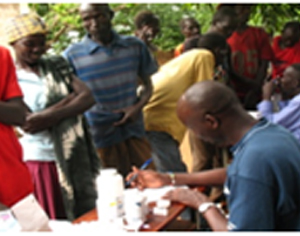Ethiopia is a country divided into 11 national regional states. Among the 11th regions, Gambella is one of the poorest and most marginalized regional state located in the western part of Ethiopia about 660 km from Addis Ababa, the capital of Ethiopian. It size is 25,802.01 square kilo meters with estimated population of over 306,916, consisting of 159,679 men and 147,237 women; urban inhabitants number 77,878 (25.37%) of the population. The main nationalities of the region are Anyuak, Komo, Mezhenger, Nuer, and Opo. Moreover, the other ethnic groups predominantly from highland of Ethiopia are living in the region. While most population of Gambella are christens, about 70% of them is Protestant, 16.8% Orthodox Christian, 3.8% practice traditional religions, 4.9% Muslim, 3.4% Catholic, and others constitute 1.1%.
Gambella has poor health status relative to other region of Ethiopia. This is largely due to attribute to preventable infectious ailments and nutritional deficiencies. Infectious and communicable diseases account for about 60-80 % of the health problems in Gambella. The major causes of outpatient visits at the Gambella’s health institutions are malaria, intestinal helminthiasis (a disease resulting from infestation with parasitic worms), and acute respiratory tract infections including pneumonia, tuberculosis and skin diseases. Outbreaks of meningitis, measles and diarrheal diseases including cholera are also common during rainy season. Periodically, the area experience heavy seasonal rains, which cause flooding leading to internal displacement and increased risk for diseases related to stagnant waters such as malaria and cholera. The widespread food shortages associated with these natural disasters further results in malnutrition and under-nutrition. Widespread poverty along with general low income levels of the population, low education levels (especially among women), inadequate access to clean water and sanitation facilities, and poor access to health services have contributed to the high burden of ill-health in Gambella.
It is imperative that the health sector is prepared to meet the additional health burden resulting from natural disasters and man-made emergencies. One of the steps in this regard is for GmTc to provide periodical screening to make nutritional and health needs assessments among vulnerable groups. The other step is to build the required health care services including educating the community about infectious diseases prevention. Additional logistics may also be required to assist the implementation of the programs in times of emergency and disaster. GmTc also will provide mechanisms of monitoring of the nutritional status of children as well as the impact of interventions (nutritional surveillance system) as much as possible.


GmTc Main Focus in Gambella


The main purpose of GmTc in Gamblla is to improve quality of life for those who are vulnerable and suffering from infectious disease, such as tuberculosis (TB), Malaria, cholera, and HIV/AIDS in the Gambella Regional State of Ethiopia. Like people in other countries of the World, specifically countries of Sub-Sahara Africa, people in Ethiopia including people in Gambela Region, are facing burden of infectious diseases. While most of the deaths from these infectious diseases such as diarrheal cholera are preventable, due to lack of hygiene and clean drinking water, most lives of people living in the region are lost annually. That means health education about diseases mode of transmission and how to prevent the transmission is critical at community level. For example, education about HIV/AIDS, to know how the virus is spread and how to avoid becoming infected is important for the teenagers, youth, and widows whom have lost husbands or wives to HIV/AIDS. GmTc will educate people about health issues and dispels common myths about those viruses and equips the patient with facts. Staff will discuss about other important topics, such as hygiene, nutrition, prenatal care, and dental care.
In addition to infectious diseases, the people of Gambella are facing burden of non-communicable diseases (NCDs) in the recent years. The nature of most NCDs requires a well-integrated healthcare system to meet chronic healthcare needs. This poses a challenge for nations faced with limited human, financial, and infrastructure resources. This is especially true in Gambella Regional State of Ethiopia where NCDs already account for many deaths and the healthcare workforce is deficient by approximately hundreds of workers to meet even basic healthcare needs. The proportion of deaths in Gambella attributable to NCD risk factors-such as cancers, hypertension, and diabetes-has increased in the past decade. In response to these statistics, innovative models of healthcare delivery that integrate novel use of human and technological resources are required as priorities for the Gambella region.
